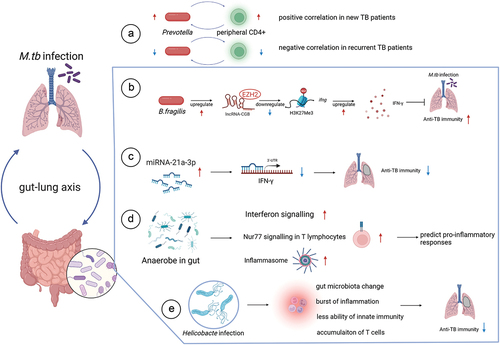Figures & data
Figure 1. (A) Prevotella and peripheral CD4+ cells were positively correlated in new-onset TB patients, whereas showed a negative correlation in relapsed TB patients. (B) Bacteroides fragilis upregulated the lncRNA-CGB, which then contacts EZH2 of histone methyltransferase PRC2, negatively controlling the epigenetic regulation of H3K27Me3, leading to increased expression of IFN-γ and a robust capacity to against Mtb. (C) miRNA-21 was predicted to interact with IFN-γ during the dysbiosis of the gut microbiota after constructing a “loss-of-function” model. Then the IFN-γ expression was decreased, which in turn leads to a weakened anti-TB immune function. (D) Anaerostipes may actively engage with “interferon signalling”, “Nur77 signalling” and “inflammasome” pathways, all of which are aimplicated in the pro-inflammatory responses to TB, and therefore it may predict pro-inflammatory responses. (E) The colonization of Helicobacter in mice promoted changes in the gut microbiota, outbreak of inflammation,reduced innate immunity and accumulation of activated T cells, all of which resulted in a loss of the immunity to suppress Mtb infection.

Table 1. Impact of antibiotic therapy on the gut-lung microbiota in TB patients.
Table 2. Dysbiosis of gut and lung microbiota in TB.
Data availability statement
The datasets generated or analyzed during this study are available in PubMed.
